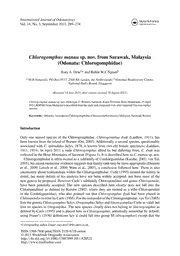
Chlorogomphus manausp. nov. from Sarawak, Malaysia (Odonata: Chlorogomphidae) PDF
Preview Chlorogomphus manausp. nov. from Sarawak, Malaysia (Odonata: Chlorogomphidae)
InternationalJournalofOdonatology Vol.14,No.3,September2011,269–274 Chlorogomphus manau sp. nov. from Sarawak, Malaysia (Odonata: Chlorogomphidae) RoryA.Dowa*andRobinW.J.Ngiamb aNCBNaturalis,POBox9517,2300RALeiden,theNetherlands;bNationalBiodiversityCentre, NationalParksBoard,Singapore (Received14June2011;finalversionreceived30August2011) Chlorogomphusmanausp.nov.(holotype♂:Borneo,Sarawak,KapitDivision,HoseMountains,15April 2011,RMNH)fromMalaysiaisdescribedfromthemaleandcomparedwithotherregionalChlorogomphus species. Keywords: Odonata;Anisoptera;Chlorogomphidae;Chlorogomphusmanau;Malaysia;Sarawak;Borneo Introduction Only one named species of the Chlorogomphidae, Chlorogomphus dyak (Laidlaw, 1911), has beenknownfromtheislandofBorneo(Orr,2003).Additionallyasecondspecies,questionably associatedwithC.splendidusSelys,1878,isknownfromtwooldfemalespecimens(Laidlaw, 1911, 1914). In April 2011 a male Chlorogomphus allied to, but differing from, C. dyak was collectedintheHoseMountainsofSarawak(Figure1).ItisdescribedhereasC.manausp.nov. ChlorogomphidaeisoftentreatedasasubfamilyofCordulegastridae(Karube,2002;vanTol, 2005),butrecentmolecularevidencesuggeststhatfamilyrankmaybemoreappropriate(Dumont et al., 2009; Letsch et al., 2009; Ware et al., 2007), a conclusion followed here. There is also uncertaintyaboutrelationshipswithintheChlorogomphidae;Carle(1995)treatedthefamilyin detail, but many details of his analysis have not been widely accepted, nor have most of the newgeneraheproposed.HoweverCarle’ssubfamilyChloropetalinaeandgenusChloropetalia, have been generally accepted. The new species described here clearly does not fall into the Chloropetalinae as defined by Karube (2002; where they are treated as a tribe Chloropetalini in the Cordulegastridae), who also pointed out that Chlorogomphus dyak had been placed in ChloropetaliainerrorbyCarle(1995).FortheremainderoftheChlorogomphidae,vanTol(2005) liststhegeneraChlorogomphusSelys,OrogomphusSelysandSinorogomphusCarleasvalid,but lists no species in Orogomphus.The new species clearly does not belong to Sinorogomphus as definedbyCarle(1995)andisplacedhereinChlorogomphus,admittedlysomewhatbydefault; using Fraser’s (1936) definitions key it could fall into group III (Orogomphus) except that the *Correspondingauthor.Email:[email protected] ISSN1388-7890print/ISSN2159-6719online ©2011WorldwideDragonflyAssociation http://dx.doi.org/10.1080/13887890.2011.620522 http://www.tandfonline.com 270 R.A.DowandR.W.J.Ngiam Figure 1. Chlorogomphusmanausp.nov.holotypemale;photographbyRobinW.J.Ngiam. abdomenisnot“markedlylongerthanthehind-wing”.Similarly,withCarle’s(1995)keyitcould fall into either Chlorogomphus or Orogomphus. However, if Fraser’s definitions were followed then,forinstance,C.dyakcouldalsobeplacedinOrogomphus,whereinfactitwasoriginally described.WefeelthatOrogomphusispoorlycharacterised,andasthenewspeciesfurtherblurs thedistinctionbetweenChlorogomphusandOrogomphus,itisbestplacedinChlorogomphus. TheidentityofthefemaleChlorogomphusfromSarawakreferredquestionablytoC.splendidus hasremainedamystery;C.splendidusitselfisanenigmaticspecies,knownwithcertaintyonly fromthefemaletypefromLuzoninthePhilippines(Selys,1878).SeeFraser(1929,p.158)and Lieftinck (1954, p. 112, footnote) for further discussion of these female specimens. However, C. manau is unlikely to be the male of Laidlaw’s species or of the true splendidus, as it is a significantlysmallerinsectthanthefemalesofthesespecies.Thusitappearslikelythatatleast threeChlorogomphusspeciesoccurinBorneo,allofwhichhavebeenrecordedfromSarawak.It isnotpossibletodeterminetherelationshipofC.manautothefemaleChlorogomphusreported fromTabinWildlifeReservebyKitagawaetal.(1999)fromthepublishedinformation. BorneanChlorogomphusseemtobeexceptionallyelusiveinsects.Thereappeartobenorecords fromBruneiorKalimantanandtheonlyrecordsofadultChlorogomphusfromSarawak,thatwe are aware of, are those referring to the type series of C. dyak and the females associated with C. splendidus, and of two additional females of C. dyak in Hincks (1930); all of these records date from prior to 1930. Laidlaw (1934) reported C. dyak from Mount Kinabalu in Sabah; the whereaboutsofthisspecimenisunclear.TheonlyotherrecordfromSabahappearstobeofthe female, unidentified to species, in Kitagawa et al. (1999). The first author and associates have beenconductingextensivefieldworkinSarawaksince2005;theholotypeofC.manauisthefirst adultChlorogomphusthathascomeintohishands.S.ButlerhascollectedsingleChlorogomphus larvae on Mount Dulit and on Gunung Mulu; it was not possible to rear these to adulthood, so theiridentityremainsamystery. Materialandmethods ThespecimenwascompareddirectlywiththetypeandparatypesofC.dyakintheNaturalHistory Museum,London(BMNH)andaparatypeofC.dyakinNCBNaturalis,Leiden(RMNH),aswell aswithotherregionalChlorogomphusspeciesinthesecollections. Chlorogomphusmanausp.nov. 271 Allspecimenswereexaminedusingstereomicroscopes.Measurementsweremadewiththeaid ofameasuringeyepiececalibratedtoaknownscale.Theoriginalillustrationsweremadewithor withtheaidofaLeicaMZ16AequippedwithaLeicaDFC500camera,motorfocusingandLAS auto-imagingsoftwareattheRMNH. Chlorogomphusmanausp.nov. (Figures1,2,3b,4c,d) Etymology Manau,anouninapposition;namedforourfriendManauanakBudi,whocomesfromtheHose RangeareaofSarawak,andwhocollectedtheholotype. Specimensexamined Holotype(cid:2):SAR11_12_CHR1,Borneo,EastMalaysia,Sarawak,KapitDivision,HoseMoun- tains,bysideofoldloggingroad,600-700m,15iv2011,leg.M.Budi.TobedepositedinRMNH (Leiden). Figure 2. SynthoraxofC.manauholotype:(a)dorsal;(b)lateral. Figure 3. AccessorygenitaliaofC.dyakandC.manau:(a)C.dyakparatype;(b)C.manauholotype. 272 R.A.DowandR.W.J.Ngiam Figure 4. CaudalappendagesofC.dyak,adaptedfromFraser(1929,figure35),andC.manau:(a)C.dyakdorsalview; (b):C.dyaklateralview;(c)C.manauholotypedorsalview;(d)C.manauholotypelateralview. Diagnosis A small species of Chlorogomphus, distinguished from all other species by the structure of its caudalappendagesincombinationwithitsmarkingsandshortabdomen.Inparticularitisdistin- guishedfromthemalesofthesimilarlypatternedC.dyakandC.yoshihiroiKarube,1994,with which it might co-occur, by the tooth on the superior anal appendages clearly visible in dorsal viewandtheshapeofthetipofthesuperiorappendageandofthebranchesofthedeeplydivided inferiorappendage. Descriptionofholotypemale Head. Labium brownish yellow. Labrum black.Anteclypeus brownish grey, postclypeus yel- lowish green. Frons black except narrowly along ridge of antefrons, where yellowish. Occiput black. Thorax. Pronotumwithanteriorandmiddlelobesblackexceptalonganteriorridgeofanterior lobe, where yellow; posterior lobe brown, greyish laterally. Propleuron obscurely yellow and brown.Synthoraxblackwithgreenishyellowmarkings(Figures1,2a,b):pairofnarrowhumeral stripes, expanded slightly near antealar carina, a pair of broader antehumeral stripes continued ontomeseinfraepisternum,regionbetweenhumeralandantehumeralstripesdiffuselypalenear prothorax,metepisternalstriperunningfromantealarcarinatospiracleandcontinuingontomete- infraepisternum, yellow metepimeral stripe. Legs largely black but with coxae and trochanters of anterior two pairs brownish yellow, this just carried onto the extensor surface of femur, and brownishyellowstripealongtherearoftheposteriorcoxae.Wings:hyaline,Pterostigmablack, coveringfromjustovertwotothreeunderlyingcells.Trianglescrossedonceinallwings.Anal Chlorogomphusmanausp.nov. 273 loopwith8cells,analtrianglewith3cells.20AxinFw,14(left)or17(right)inHw;12(left)or 11(right)PxinFw,14inHw. Abdomen. SlenderbutexpandedslightlyfromcircamidwayalongS6,widestaroundS7–8,then gently tapering. Black with yellow markings: S1 with transverse lateral apical stripe separated from apical dorsal stripe; S2 with narrow yellow ring, divided dorsally, situated immediately behindtransversecarina,runningoverupperpartofauriclewhereitbroadensandturnstomeet S1, and narrow apical yellow ring, barely divided dorsally. S3 with narrow yellow ring behind transverse carina, barely interrupted dorsally and bi-lobed transverse apical dorsal stripe. S4–5 withbi-lobedapicaldorsalmarkings,thatonS5smallandjustdividedintotwoparts.S6withlarger apicaldorsalmarking.S7–10black.AdditionallyS2–S9withyellowstriperunningalonglower margin of tergite, broadest on S2, where continuous with the apical ring, becoming narrower and less distinct on successive segments, and only visible in ventral view after S3.Accessory genitalia as shown in Figure 3b. Caudal appendages (Figures 4c, d) black. Superior appendage with lateral ventral tooth at circa two thirds length, clearly visible in dorsal as well as lateral view, appendage slightly in-turned from this point and slightly down-turned at the tip. Inferior appendageslightlylongerthansuperiorpair,deeplydivided,tipofeachbranchslightlyupturned, each with double tooth, branches with their tips only slightly outside of those of the superior appendages. Measurements (mm). Hw 38.5, abdomen 42.5 (excluding appendages), superior appendage c.1.5. Remarks Chlorogomphus manau is very similar in general appearance to C. dyak and C. yoshihiroi. It differs from these species most notably in its caudal appendages and accessory genitalia. The caudal appendages of C. dyak are shown for comparison in Figures 4a, b, and its accessory genitalia in Figure 3a. The tooth on the superior appendage is positioned more laterally in C. manau than in the other two species, so that it is clearly visible in dorsal view. The tip of the superior appendage of C. manau is shaped differently from that of C. dyak, which is shaped similarlytothatofC.yoshihiroi.ThetipsofthebranchesoftheinferiorappendageinC.dyak are markedly more produced dorsally than that of C. manau, whereas that of C. yoshihiroi is barelyupturned.ThebranchesoftheinferiorappendageinC.manauarelesswidelyseparated thanthoseofeitherC.dyakorC.yoshihiroi,butfarmoredeeplydivided.Itdiffersfurtherfrom these two species in that the abdomen is relatively shorter compared with the Hw, ratio c.1.14 (includingcaudalappendages)inC.manaubutalmost1.4onaverageinC.dyak;thisdifference isimmediatelyapparentwhenspecimensaredirectlycompared.Theposteriorpronotallobeof C. manau is brown whereas that of C. dyak bears yellow marks and that of C. yoshihiroi has greenishyellowmarkings(Karube,1994,p.8).Thereareothersmalldifferencesinthemarkings of the thorax and abdomen. Judging from Karube’s illustration (Karube, 1994, figure 5) the accessory genitalia of C. yoshihiroi is closely similar to that of C. dyak, but that of C. manau differs quite markedly, as can be seen from Figure 3, particularly in the shapes of the hamules andthevesicle. There are greater differences in markings, as well as in the caudal appendages, between C. manau and other species from the Chlorogomphidae known from Sundaland: Chlorogomphus arooni Asahina, 1981, C. magnificus Selys, 1854 and Chloropetalia kimminsi (Fraser, 1940). With an abdomen length including appendages of just c.44 mm, C. manau is one of if not the smallestspeciesknownfromtheChlorogomphidae. 274 R.A.DowandR.W.J.Ngiam Distribution ChlorogomphusmanauissofaronlyknownfromtheHoseMountainsinSarawak’sKapitdivision. Acknowledgements CollectinginSarawakin2011wasconductedbypermissionoftheSarawakForestryDepartment(SFD)andSarawak ForestryCorporation(SFC);thanksareduetoalloftheSFDandSFCstaffwhoassistedus.FieldworkintheHoseMoun- tainswassupportedbygrantSUB.2010.12.03fromUyttenboogaart-EliasenStichtingandagrantfromtheInternational DragonflyFund;theparticipationofR.W.J.NgiamwasfundedbytheNationalParksBoard,Singapore.MikeMayand KeithWilsonmadeconstructivecommentsonthemanuscriptatreview,whichhavegreatlyimprovedit.DaveGodgerhas providedthefirstauthormuchassistanceattheBMNH.SpecialthanksareowedtoourteamintheHoseMountainsin 2011:ManauanakBudi,SomohanakNyangon,LukeSouthwell,Mibang(Mathias)KibiandAntoniusKubieanakKaya. References Carle,F.L.(1995).Evolution,taxonomy,andbiogeographyofancientGondwanianLibelluloides,withcommentson Anisopteroidevolutionandphylogeneticsystematics(Anisoptera:Libelluloidea).Odonatologica,24,383–424. Dumont,H.J.,Vierstraete,A.,&Vanfleteren,J.R.(2009).AmolecularphylogenyoftheOdonata(Insecta).Systematic Entomology,35,6–18. Fraser,F.C.(1929).ArevisionoftheFissilabiodae(Cordulegasteridae,PetaliidaeandPetaluridae)(OrderOdonata).Part I.–Cordulegasteridae.MemoirsoftheIndianMuseum,9,69–167,platesIX–XII. Fraser,F.C.(1936).TheFaunaofBritishIndia,includingCeylonandBurma.Odonata.Vol.III.Taylor&Francis,London, pp.xi+461,platesI–II. Hincks,W.D.(1930).SomenotesonacollectionofSarawakOdonata.SarawakMuseumJournal,4,49–56. Karube,H.(1994).AnewspeciesandanewlyrecordedspeciesofthegenusChlorogomphus(Odonata,Cordulegastridae) fromWestMalaysia.BulletinKanagawaprefecturalMuseum(NaturalSciences),23,7–12. Karube, H. (2002). Watanabeopetalia gen. nov., a New Genus of the Dragonflies (Odonata, Cordulegastridae, Chlorogomphinae).SpecialBulletinoftheJapaneseSocietyofColeopterology,Tokyo,5,67–85. Kitagawa,K.,Yagi,T.,Nakanishi,A.,Wahid,N.,&Mohamed,M.(1999).DragonfliesofTabinwildlifereserve.In M.Mohamed,M.Andau,M.N.Dalimin,&T.P.Malim,TabinScientificExpedition(pp.79–85).KotaKinabalu: UniversitiMalaysiaSabah. Laidlaw,F.F.(1911).DescriptionsoftwospeciesofDragonflies(Odonata)fromSarawak.JournalStraitsBranchRoyal AsiaticSociety,57,190–193. Laidlaw, F.F. (1914). Contributions to a study of the dragonfly fauna of Borneo. Part II. The Gomphinae and Chlorogomphinae.ProceedingsZoologicalSocietyLondon,1914,51–63,plateI. Laidlaw,F.F.(1934).Anoteonthedragonflyfauna(Odonata)ofMountKinabaluandofsomeothermountainareasof Malaysia,withadescriptionofsomeneworlittleknownspecies.JournaloftheFederatedMalayStatesMuseums, 17,549–561. Letsch,H.O.,Greve,C.,Kück,P.,Fleck,G.,Stocsits,R.R.,&Misof,B.(2009).Simultaneousalignmentandfoldingof 28SrRNAsequencesuncoversphylogeneticsignalinstructurevariation.MolecularPhylogeneticsandEvolution, 53,758–771. Lieftinck,M.A.(1954).HandlistofMalaysianOdonata.AcatalogueofthedragonfliesoftheMalayPeninsula,Sumatra, JavaandBorneo,includingtheadjacentsmallislands.Treubia(Supplement),22,i–xiii+1–202. Orr,A.G.(2003).AGuidetotheDragonfliesofBorneo:TheirIdentificationandBiology.KotaKinabalu:NaturalHistory Publications(Borneo). Selys-Longchamps,E.de(1878).Quatrièmesadditionsausynopsisdesgomphines.(II).BulletinAcademieroyaleBelgique Serie,2,46(12),659–698. vanTol,J.(2005).GlobalSpeciesDatabaseOdonata.RetrievedJune8,2011fromhttp://www.odonata.info. Ware,J.,May,M.,&Kjer,K.(2007).PhylogenyofthehigherLibelluloidea(Anisoptera:Odonata):Anexplorationofthe mostspeciosesuperfamilyofdragonflies.MolecularPhylogeneticsandEvolution,45,289–310.
